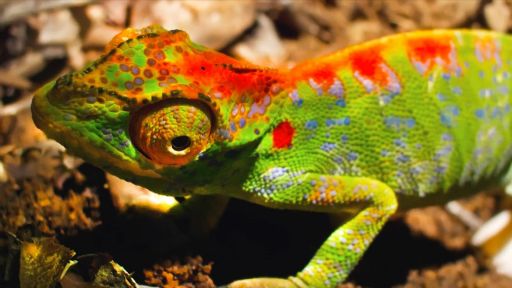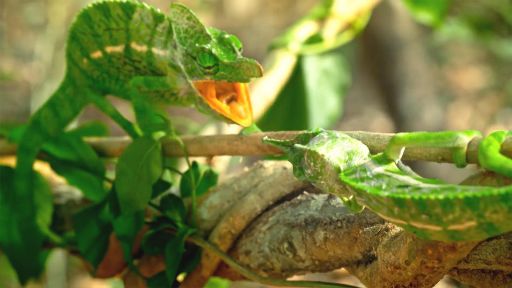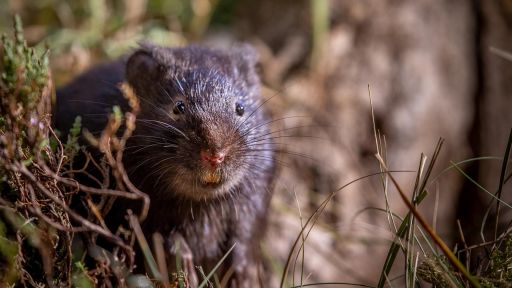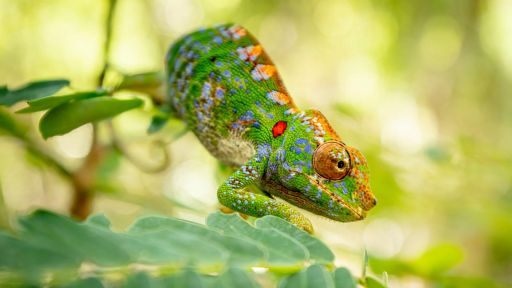The Big Little Journeys team travels through storms and fallen trees to reach the remote Kirindy Forest in Madagascar. Here they work with local scientists to film the short-lived journey of a matchstick-sized chameleon. Its life is finely in tune with the seasons and the team discovers how this leaves them vulnerable to the effects of a warming world. Narrated by Aaron Pierre.
Features




- [Narrator] Filming six little animals required a collaboration between TV crews and scientists around the world.
- Wow.
- Oh wow!
(chuckling) - [Narrator] Over two years, the team filmed on five continents in order to follow these journeys.
The most remote location was western Madagascar's Kirindy Forest, the home of one of the most extraordinary journeys of all.
Traveling in the cyclone season, the first challenge was getting to the forest.
(water splashing) But the team's journey comes to a halt when a fallen tree blocks their only way in.
It's a long way back for help.
At least someone brought an ax.
(rhythmic chopping) - Yeah, it looks like pretty tough going, so could be here a while.
- [Narrator] Four hours later, progress is slow.
With the tree finally chopped into pieces, they must still drag it out of the way.
(indistinct conversations) There are several miles to go yet.
- We've just arrived after 13 hours of driving and I'm amazed that the car's actually made it through the amount of water with no electricity and this absolutely torrential rain.
(thunder rumbling) - [Narrator] With a break in the rain, the team can finally start searching for the chameleons.
(insects chirping) One of the scientists studying the forest's chameleons is Ludo Raoelina.
- During the day, it's so difficult to find them.
It's better to search at night.
- [Narrator] Finding a reptile no bigger than a human finger is challenging.
Luckily, chameleons turn pale at night and sleep at the end of branches, making them easier to find by spotlighting.
Cameras at the ready, things finally seem to be going well for the team.
(loud claps of thunder) - Whoa!
Did you see that?
We were just about to start filming and just, yeah, just torrential.
- Just so wet.
- You could literally ring me out, literally ring me out.
- [Narrator] Filming has to stop.
(gentle bright music) After several days, the storm passes, but the fleeting life cycle of the Kirindy chameleons is moving fast.
Ludo is joined by Christopher Raxworthy, who has been studying chameleons in Kirindy for decades.
- I have been fascinated with chameleons since I was a young boy, and Madagascar was always a special place.
(speaking foreign language) If you want to see these chameleons, Kirindy is the place to come to.
- [Narrator] Kirindy isn't just a haven for chameleons.
- This forest is incredible.
Loving all of the amazing animals that we're finding in the forest.
We've seen sifakas and brown lemurs and loads of beautiful birds, beautiful butterflies.
- [Narrator] Some of the wildlife has taken a shine to one member of the team.
- [Valeria] So Owen and I are currently in a tornado of flies.
You having fun, Owen?
- No.
- [Valeria] Why are you not having fun?
- [Owen] (laughing) Because the flies like me too much.
- [Narrator] Despite the challenges, the team are able to document every element of this extraordinary lifecycle for the very first time.
(bright playful music) But they may also be filming this for the very last time.
(bright music continues) These chameleons hatch, grow up, and die during one season.
(gentle music continues) This unique lifecycle has left them very vulnerable.
- It seems like a very risky strategy to actually put literally all your eggs in one basket.
You could imagine if the eggs didn't hatch, then there's no backup generations to keep the population going.
- [Narrator] With their lives so intimately in sync with the seasons, a shift in the climate could be devastating.
- The rainy season now starts in Madagascar perhaps as late as two months later than when I first started working in Madagascar.
- [Narrator] And it's not just the climate that is changing.
- The environmental pressures on Kirindy have increased over the last 20 or 30 years.
And so the great news is we have a lot more forests now, which is protected with inside reserves, but we also can tell from satellite images and from, y'know, personal experience that we can still see ongoing declines in terms of the total forest area.
- [Narrator] Over the last 70 years, half of Madagascar's forests have been destroyed, putting much of its unique wildlife, including the chameleons, at risk of extinction.
- Sadly, I have seen forests that I worked in and love being degraded and cleared, and so that's a very painful experience to sometimes see that kind of biodiversity loss.
(speaking foreign language) (building hopeful music) - [Narrator] Ludo and many other local scientists are determined to preserve the remaining wildlife.
(speaking foreign language) - [Narrator] The work of dedicated conservationists around the world is helping the tiny animals featured in this series to continue their journeys for many generations to come.
